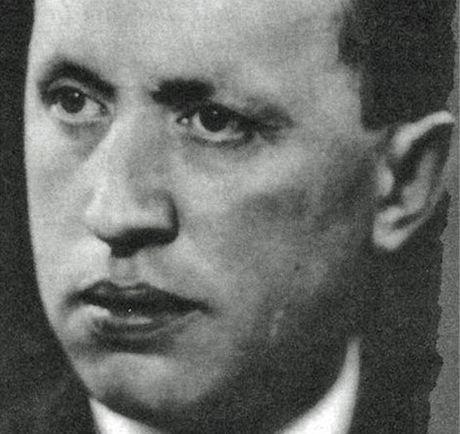Vengeful Amphibians and Gastronomic Extravaganzas

Karel Capek (pictured) and Gyyula Krudy, two major figures in European literature, have waited a long time for a new audience. The reprinting of two of their masterpieces is cause for celebration. Review by Edward O’Hare
Penguin’s revival of ten masterworks by central European writers has been one of the unexpected delights of the reading year. A whirlwind tour of a whole range of political, philosophical and spiritual ideas dating back to the first third of the last century, not to mention a sumptuous banquet of literary styles and voices, it has brought back into print many important writers. Some achieved fame in their day before fading into obscuring. Others were never even translated and are appearing in English here for the first time. Two of the more unusual volumes in this series are Karel Capek’s War With the Newts and Gyula Krudy’s Life is a Dream, books which, even by 21st century standards, are astonishing achievements.
Karel Capek, a Czechoslovakian, and Gyula Krudy, a Hungarian, were rough contemporaries. Both were born in the last decades of the 19th Century and both were prematurely dead by the close of the 1930’s. Each enjoyed considerable success, with Capek’s work reaching international recognition. Where they diverge is their approach to fiction. Capek’s style is cool, logical and meticulous, heavy with figures and detail and carried off with the driest of wit. Krudy’s style is warm, whimsical and meandering, bursting with ribaldry and much more like the kind of apocryphal stories shared between old friends before a smouldering fire late on a cold winter’s night.
Karel Capek’s most famous contribution to literature was the word ‘robot,’ first used in his play R.U.R. in 1920, an allegory about slave labour. War With the Newts deals with a similar theme, the discovery of a race of beings coerced into serving mankind. A breed of giant newt is found living in a remote Sumatran lagoon. Czech sea captain van Toch makes the initial bargain with these extraordinary salamanders. In return for knives which allow them to open shellfish he keeps the pearls found inside. Going into business with industrialist G.H. Bondy, van Toch soon realizes that with their power to use tools, speak and learn these newts have the potential to change the world.
And change the world they do, first by building enormous dams and then constructing vast underwater cities at the behest of their human masters. Soon the avarice of the different nations grows unstoppable and the newts are ordered to conquer new territories. Global conflict becomes imminent, but in the end its the newts who take their revenge. War With the Newts is a strange mixture of science-fiction, satire and surrealism and in this, and its clever use of invented newspaper reports, scientific journal entries, board-room minutes and even letters by celebrities like Mae West and G.B. Shaw, it strongly anticipates the kind of absurdist postmodern fiction that would not appear in America for another thirty years.
While the book is undermined by its lack of introduction and outdated and monotonous translation, and Capek’s ingenious premise isn’t quite enough to sustain a work of this length, War With the Newts still wows the reader with its abundance of crazed comic moments. Moreover, the novel’s valiant defence of human freedom remains relevant. Capek rose to global prominence through his vehement criticism of Nazi Germany (ironically, it was this that cost him the Nobel prize early in the 1930’s) and did much to alert Britain and America to it’s deadly intentions. It doesn’t take much imagination to see the desperate warning about totalitarianism that lies behind his words.
Equally satisfying, but for very different reasons, is Life is a Dream, Gyula Krudy’s 1931 collection of short stories centring on the bizarre citizens of fin de siecle Budapest, superbly translated for the first time by John Bakti. Krudy came from an aristocratic family but was disinherited when he pursued a literary career. His protagonists are hack writers, bartenders, femme fatales, painters, duellists, debt collectors, lunatics and lonely beautiful maidens, an entire rogues gallery of louche, bibulous bohemianism. The twilight world they inhabit is a realm where reason plays little part and magic is nothing unusual.
In these stories an assassin spends a day in a tavern empathising with his quarry while impoverished journalist Titusz Finedwell, the man who is to die, gains a new lease of life when he acquires the assassin’s hat and umbrella. An aging rogue gets the better of both his wife and his mistress when he lapses into suspended imagination. Food, drink, and the replenishment of the personality through consumption is a common thread linking these tales. Some, like The Landlady, a hilarious celebration of cabbage-trampling, are gastronomic extravaganzas.
At the heart of this collection is the truly glorious novella The Green Ace or the History of the Wine Jug, in which heartbroken barmaid Jolan and her elderly mentor in the ways of romance, the bon viveur Mr. Rimaszombati, try to rescue Jolan’s fiancé from the custody of the Temperance movement. Like the rest of the Krudy’s stories, this is a sublime mixture of humour and pathos, a spellbinding rumination on life as wise as it is funny. Overflowing with treasure, these two volumes have a rightful place in the library of any lover of world literature
War With the Newts by Karel Capek; pp 348
Life is a Dream by Gyula Krudy; pp 226
Published by Penguin
€12
